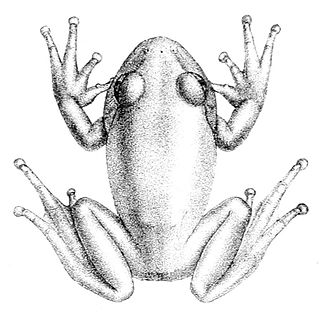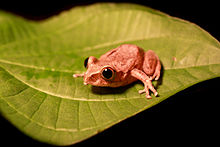
Cardioglossa is a genus of frogs in the family Arthroleptidae known as long-fingered frogs. They are native to western and central Africa, with the greatest species richness in Cameroon. They are found near streams in lowland and mountain forests, but also occur in other highland habitats near streams at up to 2,700 m (8,900 ft) in altitude. These are small frogs with a snout-to-vent length of 2 to 4 cm (0.8–1.6 in). Some of the more localized species are threatened.

Leptopelis is a genus of frogs in the family Arthroleptidae. They are found throughout Sub-Saharan Africa, excluding Madagascar. It is placed in monotypic subfamily Leptopelinae, although this subfamily is not always recognized. They have a number of common names, including forest treefrogs, tree frogs, leaf-frogs, and big-eyed frogs.

Astylosternus batesi is a species of frog in the family Arthroleptidae. It is found in Cameroon south of Sanaga River, Equatorial Guinea, Gabon, southwestern Central African Republic, the Republic of the Congo, and the extreme western Democratic Republic of the Congo (Mayombe). The specific name batesi honours George Latimer Bates, an American naturalist. However, its vernacular name is Benito River night frog, apparently in reference to its type locality, Benito River in Equatorial Guinea.
Bocage’s tree frog is a species of frog in the family Arthroleptidae. It is found in Angola, Burundi, Cameroon, Democratic Republic of the Congo, Ethiopia, Kenya, Namibia, Rwanda, Tanzania, Zambia, and Zimbabwe, and possibly Botswana, Central African Republic, Chad, Malawi, Mozambique, Nigeria, Sudan, and Uganda.
Leptopelis boulengeri is a species of frog in the family Arthroleptidae. It is found in southeastern Nigeria, southern Cameroon, Equatorial Guinea, Gabon, Republic of the Congo, and western Democratic Republic of the Congo. It is expected to be found in the Central African Republic and the Cabinda Enclave of Angola. Common name Victoria forest treefrog has been coined for it, apparently in reference to its type locality, "Victoria, Kamerun", now known as Limbe.

The Cameroon forest tree frog is a species of frog in the family Arthroleptidae. It is found in southern Nigeria, Cameroon, Equatorial Guinea, and Gabon. It is expected to occur in southwestern Central African Republic and in the Republic of the Congo, but no records have been confirmed from those countries.

Leptopelis calcaratus is a species of frog in the family Arthroleptidae. It is found in southeastern Nigeria, Cameroon, the southwestern Central African Republic, Equatorial Guinea, Gabon, the Republic of the Congo, and the Democratic Republic of the Congo. Common name Efulen forest treefrog has been coined for it.
Leptopelis jordani is a species of little-known frog in the family Arthroleptidae. Common name Congulu forest treefrog has been coined for it.

Leptopelis millsoni is a species of frog in the family Arthroleptidae. It is found in southeastern Nigeria, Cameroon, the Central African Republic, Equatorial Guinea, Gabon, the Republic of the Congo, the eastern Democratic Republic of the Congo, and northwestern Angola. Common names Niger forest treefrog and Millson's Tree Frog have been coined for it. There is a need of taxonomic revision of this taxon.
Leptopelis modestus is a species of frog in the family Arthroleptidae. Its common names are modest forest treefrog and plain tree frog.
The common forest tree frog is a species of frog in the family Arthroleptidae found in Angola, Cameroon, the Republic of the Congo, the Democratic Republic of the Congo, Equatorial Guinea, Gabon, Nigeria, and possibly the Central African Republic. Its natural habitats are subtropical or tropical moist lowland forest, subtropical or tropical moist montane forest, subtropical or tropical high-altitude grassland, rivers, intermittent freshwater marshes, and heavily degraded former forests.
The ocellated forest tree frog is a species of frog in the family Arthroleptidae found in Cameroon, the Republic of the Congo, the Democratic Republic of the Congo, Equatorial Guinea, and Gabon, and possibly Angola and the Central African Republic. Its natural habitats are subtropical or tropical moist lowland forest, swamps, and heavily degraded former forests. It is threatened by habitat loss.
The Kala forest tree frog, Leptopelis omissus, is a species of frog in the family Arthroleptidae found in Cameroon, the Republic of the Congo, Gabon, and Nigeria, and possibly Angola, the Central African Republic, the Democratic Republic of the Congo, and Equatorial Guinea. Its natural habitats are subtropical or tropical moist lowland forest, rivers, swamps, freshwater marshes, and heavily degraded former forests. It is threatened by habitat loss.
Leptopelis oryi, also known as the Garamba forest treefrog and Ory's tree frog, is a species of frog in the family Arthroleptidae. It is found in the northeastern Democratic Republic of the Congo, northwestern Uganda, and adjacent South Sudan. It is morphologically similar to Leptopelis nordequatorialis from Cameroon, and has also been considered its synonym, but is currently treated as a distinct species. The specific name oryi honours Albert Ory, warden in the Garamba National Park, the type locality of this species.
Leptopelis parbocagii, also known as Lake Upemba forest treefrog or cryptic tree frog, is a species of frog in the family Arthroleptidae. It is found in Angola, the Democratic Republic of the Congo, Malawi, Mozambique, Tanzania, and Zambia. The specific name parbocagii refers to its similarity to Leptopelis bocagii.

The red tree frog is a species of frog in the family Arthroleptidae. It is found in southeasternmost Nigeria, western Cameroon, Equatorial Guinea, western Gabon, the lower Republic of the Congo, the lower Democratic Republic of the Congo, and northwestern Angola. It has been confused with several other species, in particular with the palm forest tree frog Leptopelis palmatus.

Leptopelis viridis is a species of frog in the family Arthroleptidae. It is widely distributed in the West and Central African savanna zone between Senegal and the Gambia to the northeastern Democratic Republic of Congo.
Aubria subsigillata, commonly known as the brown ball frog or the West African brown frog, is a species of frog belonging to the family Pyxicephalidae. It has a discontinuous distribution from southern Guinea through Liberia and Ivory Coast, and from Nigeria to southern Cameroon, and Equatorial Guinea to Gabon. However, the species delimitation differs between sources, and the International Union for Conservation of Nature has adopted a narrower view where this species only occurs in Cameroon and southward.

Leptopelis spiritusnoctis is a species of frog in the family Arthroleptidae. It is found in West Africa from Guinea to the Niger Delta in Nigeria, the intervening countries being Sierra Leone, Liberia, Ivory Coast, Ghana, Togo, and Benin. This species was previously known as Leptopelis hyloides, but that name is actually a junior synonym of Leptopelis viridis.

Leptopelis aubryioides, the Kala forest treefrog, is a species of frog from the Leptopelis genus of the Arthroleptidae family. It is native to west equatorial Africa, where its range includes southern Cameroon, southern Republic of the Congo (RotC), Gabon, and southeastern Nigeria. It was shown to be abundant in a 2016 population study in these areas, but this is not the full extent of its range. It inhabits both dense lowland old-growth and open secondary forest around inland waters, near where its eggs are laid in ground-level nests. The species occurs at elevations of up to 1,000 m (3,300 ft).











